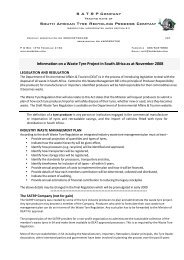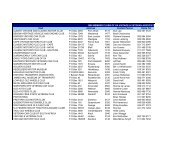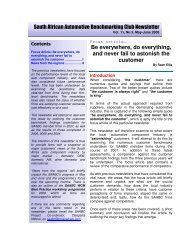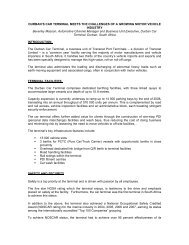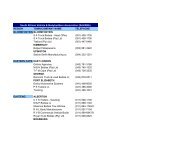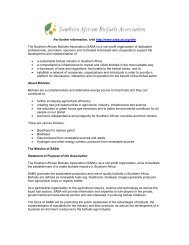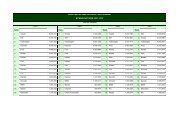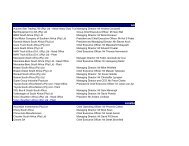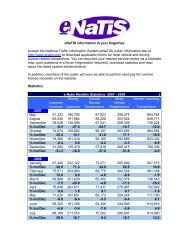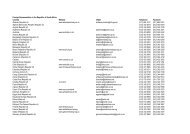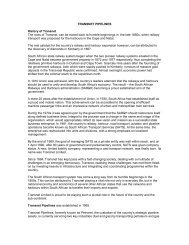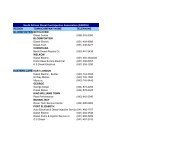Toyota South Africa Sustainability Report 2008 - Automotiveonline ...
Toyota South Africa Sustainability Report 2008 - Automotiveonline ...
Toyota South Africa Sustainability Report 2008 - Automotiveonline ...
You also want an ePaper? Increase the reach of your titles
YUMPU automatically turns print PDFs into web optimized ePapers that Google loves.
<strong>Sustainability</strong> <strong>Report</strong>_14-10-<strong>2008</strong>:Layout 1 10/14/08 2:46 PM Page 49<br />
G3 Index<br />
G3 Ref<br />
Pages<br />
G3 Ref<br />
Pages<br />
Strategy and Analysis<br />
1.1 Statement from the most senior decision maker of the organisation<br />
2<br />
1.2 Description of key impacts, risks and opportunities<br />
11<br />
Organisational Profile<br />
2.1 Name of reporting organisation<br />
IFC<br />
2.2 Primary brands, products and/or services<br />
IFC<br />
2.3 Operational structure of the organisation<br />
not<br />
reported<br />
2.4 Location of organisation headquarters<br />
3<br />
2.5 Number of countries where the organisation operates<br />
3<br />
2.6 Nature of ownership, legal form<br />
3<br />
2.7 Markets served<br />
3, 48<br />
2.8 Scale of organisation<br />
3<br />
• Number of employees;<br />
3, 47<br />
• Net sales (for private sector organisations) or<br />
47<br />
• Net revenues (for public sector organisations)<br />
47<br />
• Total capitalisation broken down in terms of debt and equity (for private sector 48<br />
organisations)<br />
• Quantity of products or services provided<br />
• Total assets<br />
• Beneficial ownership (including identity and percentage of ownership of<br />
largest shareholders)<br />
• Breakdowns by country/region of the following:<br />
• Sales/revenues by countries/regions that make up 5% or more of total<br />
<strong>Report</strong> Parameters<br />
<strong>Report</strong> Profile<br />
3.1 <strong>Report</strong>ing period<br />
3.2 Date of most recent previous report (if any)<br />
3.3 <strong>Report</strong>ing cycle (annual, biennial, etc.)<br />
3.4 Contact point for questions regarding the report or its contents.<br />
47<br />
48<br />
3<br />
47, 48<br />
revenues<br />
• Costs by countries/regions that make up 5% or more of total revenues<br />
not<br />
applicable<br />
• Employees<br />
not<br />
applicable<br />
2.9 • Significant changes during the reporting period regarding size,structure,or ownership 4<br />
2.10 Awards received in the reporting period<br />
7, 8<br />
IFC<br />
IFC<br />
IFC<br />
IFC<br />
<strong>Report</strong> Scope and Boundary<br />
3.5 Process for defining report content<br />
3.6 Boundaries of report<br />
3.7 Limitations on the scope or boundary of the report<br />
3.8 Basis for reporting on joint ventures, subsidiaries, leased facilities, outsourced<br />
operations, and other entities that can significantly affect comparability from<br />
period to period and/or between organisations.<br />
3.9 Data measurement techniques and the bases of calculations, including<br />
assumptions and techniques underlying estimations.<br />
3.10 Explanation of the effect of and reason for re-statements of information provided<br />
in earlier reports<br />
3.11 Significant changes from previous reporting periods in the scope, boundary, or<br />
measurement methods applied in the report<br />
GRI Content Index<br />
3.12 Table identifying the location of the Standard Disclosures in the report<br />
Assurance<br />
3.13 Policy and current practice with regard to seeking external assurance for the report<br />
4. Governance, Commitments, and Engagement<br />
Governance<br />
4.1. Governance structure of the organisation<br />
4.2 Indicate whether the Chair of the highest governance body is also an executive officer<br />
4.3 For organisations that have a unitary board structure, state the number of members<br />
of the highest governance body that are independent and/or non-executive members.<br />
4.4 Mechanisms for shareholders and employees to provide recommendations or<br />
direction to the highest governance body.<br />
4.5 Linkage between compensation for members of the highest governance body,<br />
senior managers, and executives (including departure arrangements), and the<br />
organisation performance (including social and environmental performance)<br />
4.6 Processes in place for the highest governance body to ensure conflicts of interest<br />
are avoided.<br />
4.7 Process for determining the qualifications and expertise of the members of the<br />
highest governance body for guiding the organisation strategy on economic,<br />
environmental and social topics<br />
IFC<br />
3,4<br />
3<br />
not<br />
applicable<br />
23<br />
47<br />
3,4<br />
49<br />
IFC<br />
7-10<br />
8<br />
8<br />
8, 31<br />
8<br />
data unavailable<br />
data unavailable<br />
<strong>Sustainability</strong> <strong>Report</strong> <strong>2008</strong> 49



